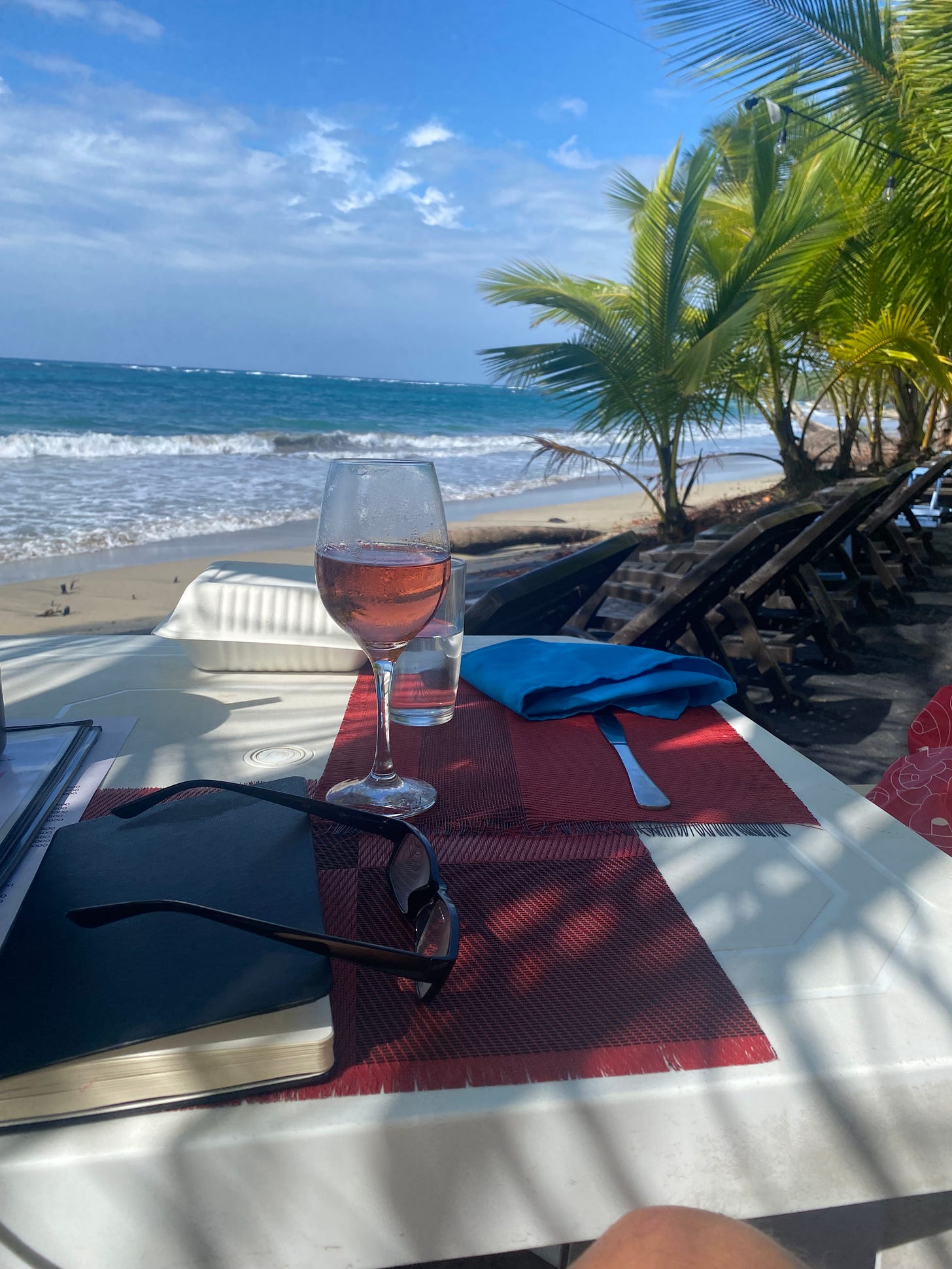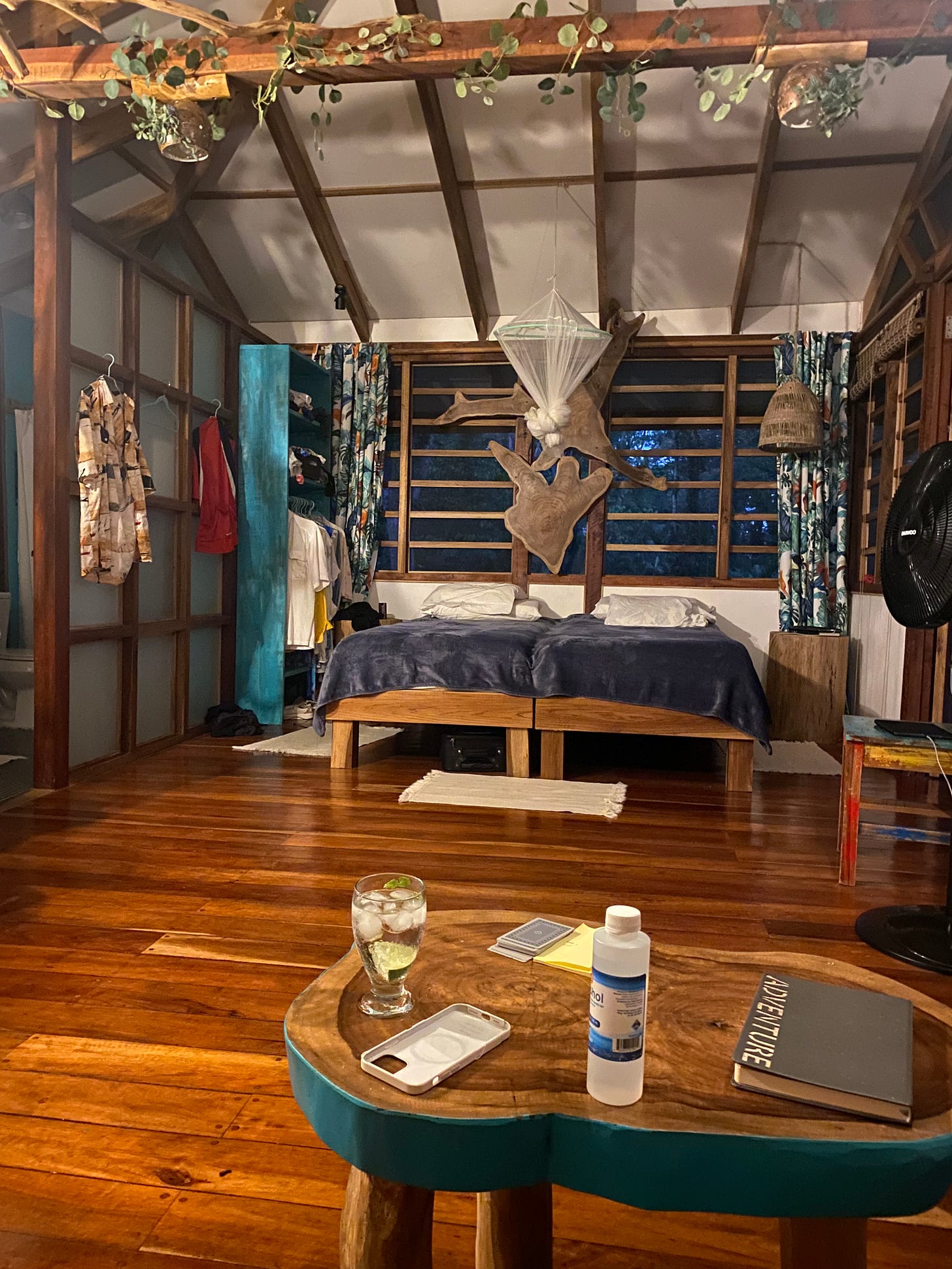Climate Vulnerability—What I Learned in Costa Rica

My time in a faraway, less prosperous part of Costa Rica taught me something crucial about climate change—our incredible vulnerability to a climate change heatwave. The Caribbean side of Costa Rica is very humid and can get quite uncomfortable in the afternoons. I would sweat just sitting in the shade in a chair. My northern blood got very uncomfortable from 10 to 3 if the sun was out, and then relief would come with clouds or evening. The sun mercifully set quickly and reliably around 5:45 for the month we were there.
During that month, I saw among the people only three air-conditioned places—the bank, the pharmacy, and one real estate office. I imagine the very expensive resorts (upwards of $500 per night) were air-conditioned as well, but I did not go into those to see them. Where the people live, there was none. Essentially, everyone lives outdoors. Most homes and businesses have no windows, just screens. Nature is very close at all times. The sea surf crashes every hour of every day. Further in, the jungle sounds never stop. In the open air, you never forget the closeness of nature.
One of many totally outdoor restaurants in Puerto Viejo area. Photo by Anthony Signorelli.
In this humidity, it would not take much of an increase in heat to make the place unbearable—only a little more to make it unsurvivable. The wet bulb temperature, that measure of humidity and heat that tells if we can cool down through natural means or not, would quickly take everyone over the top, and there would be no defense. People would seek refuge in the ocean, but you can’t sleep in the ocean. The imagination goes wild thinking of the horrors so many people would not live through. There’d be violent uprisings to get access to air conditioning. You would only need a few days of such heat and this world would be irreversibly changed.
I say “would be” as if a climate change effect were speculative. Yet even while we were there, people talked about the effects of climate change. Two straight weeks of our stay saw no rain at all, and this is in a rainforest. People had to truck in water because the wells were dry, including the place we stayed. If you can have a relative drought in a rainforest, you can certainly have a heat wave.
This area is stratified by three levels of wealth and reality. First, there are the locals who live in this beautiful simplicity, but with a hidden and awful vulnerability. Then, there are the travelers like us—renting an AirBNB at a reasonable price to our eyes, spending our time in a nicer home than many locals enjoy, yet like them, living close to nature, even if only temporarily. Third, there are high-end resorts that are always part of Central American countries. Heatwave? Turn on the AC. I'll bet, though I can't verify, the resorts even have backup power supplies.
Costa Rica is a net zero emissions country, but it has not achieved that distinction by changing the lifestyles of its citizens—at least not in this area. People use bikes, scooters, and motorcycles here because they make sense and are less expensive than cars. There are also plenty of cars and trucks. Very few vehicles were electric—that’s not how they stopped emissions. In fact, often the exhaust fumes of trucks and motorcycles hung in the air along the road, making it heavy, still, and almost noxious. This made the beach with its sea breeze, sometimes only a few feet away, a highly preferable place to be.
So people aren't doing a lot to stop climate change or restrict their emissions, but still, one wonders why they wouldn't be preparing for climate change. A certain amount of resilience would be helpful, but the answer turns out to be simple, as it is in most cases—scarcity and poverty. Nearly all items in the grocery stores are the same price or higher than at home in the US—except pineapples, mangoes, and coffee. Everything else is more expensive, sometimes double. And yet, full-time teachers are paid $600 a month—that’s about $4 an hour. I was told many people work two or three jobs to make ends meet financially.
What would be the number one resiliency strategy for a climate change heat wave? Put in air conditioning. But here’s the thing. First, air conditioning itself is expensive. Second, and more importantly, installing air conditioning would require a complete remodel of a home. Why? Because none of the homes have windows, only screens. To air condition a home, you would have to first enclose all the openings to hold in the cool air, and that is a very expensive prospect. For most people, there is just no way.
Our casita with screens, no glass. Photo by Anthony Signorelli.
In addition, even if you did all that, there’s no guarantee the electric grid could power it. The grid is haphazard, at best. Tangled electric lines hang together at the various junctions. Many live lines are exposed, enough so that the number one killer of sloths and monkeys are electric lines on a grid in disrepair. All you need to do is look at one of these junctions and you would think to yourself: I’m depending on that?
The Costa Rican grid works well enough even in this dilapidated state, but one can imagine the impact of thousands of additional air conditioners pulling energy over that grid. It seems likely to fail. As we are learning in the US and all around the world, grids tend to be built to meet today’s needs, not tomorrow’s. If tomorrow’s needs come too quickly, the grid can fail. That’s been happening in California quite a bit recently. In the future, grid limitations could severely impact the viability of EVs in the US, for example, and similar limitations could restrict the availability of cooling energy in a significant heat wave in a place like Costa Rica. Given how hot it was during the day without a heat wave, I shudder to think what it might be like.
Heat waves can be devastating, and if the grid fails and you can’t cool yourself, they can be deadly. There’s a speculative account of what such a failure might look like in Kim Stanley Robinson’s book Ministry for the Future—an account that is all too plausible and rather horrifying. In it, the grid fails during a killer heat wave. Air conditioners can’t run. Some people have generators to run them, but other people steal them at gunpoint. Those without air conditioning slowly bake to death, and that’s nearly everyone where the heat wave hits. This is what I fear could happen in a place like this area of Costa Rica. Or, for that matter, just about anywhere in the world.
Many scientists are predicting this year and the next two could have extreme heat waves because of the combination of climate change with the El Nino weather pattern. El Nino, which is the warming of the surface waters of the eastern Pacific Ocean, often disrupts weather patterns and frequently creates heat waves, droughts, or uncommonly intense storms. While one possibility is that these effects could cancel out the climate change effects of a similar but opposite nature, another possibility is that they reinforce each other making the effects that much worse. This second case is what scientists seem to be concerned about.
And so I come back to Costa Rica, where it is already hot and humid, there is no air conditioning, and where the electric grid, if there were air conditioning, probably could not handle the load. And what if a heat wave takes the wet bulb temperature up beyond the level of human survivability? It makes me shudder to think of what could happen here. It also makes me shudder to realize that the same thing could happen anywhere.
Anthony Signorelli
Free Newsletters by Anthony
Get my free newsletter Write On here! It is writers, writing, and the business of writing.
Get my free newsletter Intertwine: Living Better in a Worsening World here.
Get my free newsletter Arguments with Book here.
Get my free newsletter Soul Food: Poems by Anthony here.
Books by Anthony
To read more of my original work, try my books! All are on Amazon and published by various small presses.




Connie,
Thank you for your comment. Perhaps you have misread or I have been unclear. I made no judgments about the culture of Costa Rica, but shared impressions, and I certainly am not saying anything about overall approaches to climate change here. For the most part, I would agree that Americans could use a different approach to how we live, and I have written fairly extensively about that.
I was writing here about the ability of any place to handle extreme heat waves. I'm not talking about it being warm, but rather about killer heat--where the wet bulb temperature goes above the survivable level. This only has to happen for a few days, and when it does, I am sad to say that AC will be a survival tool no matter where in the world you are. Acclimating to a climate is critically important for the long term and can result in better strategies, as you point out. But surviving an extreme heat wave is a whole different matter.
Thanks
Dear Anthony,
I live in Costa Rica and have been living here and/or vacationing here since 2009. With all due respect, your month in Costa Rica is not enough time to make such judgments about the culture, lifestyle, infrastructure, - and how climate change will affect it.
I conclude that the United States should be learning from Costa Rica how to find alternatives to a dependence on air conditioning. Air conditioning creates more problems than it solves.
The increased extremes of heat (and cold) in the United States should be your focus: How can we build houses that are more in tune with nature's climate protections? Less concrete and more trees are the most obvious things Costa Ricans do to buffer temperature extremes. Large, shaded outdoor spaces, screen windows, open rafters that create air circulation, tile floors, no carpeting, on-demand water heaters and only cold water in the taps...I hope you begin to understand my point.
Costa Rica is not in trouble: The United States is.
We ticos do not need to learn from or imitate housing and lifestyle choices from the first world: the first world needs to learn from us. Stop building big box houses and cutting down all the trees. Stop building super-highways for more big cars:! Instead, build mass transit bus and train systems: less concrete will cool the earth. Get rid of central heating/air. All of those motors heat up the air and create the carbon emissions that are causing climate change.
With over 25% of the land mass in forest, this is another natural buffer to temperature extremes. And how about this: Learn to live in peace with other people so that more people can live in houses and thus reduce energy usage. The Caribbean region is not in trouble - it's Guanacaste that is too hot. Why? Because it has imitated the United States with cutting down trees, building big houses and malls, buying more cars, and using air conditioning. One word: Waste. I hope you will consider my point of view. Come back to Costa Rica, spend more time, listen and observe and imitate that.